Spring/Summer 2018
The Getty Acropolis:
Mountain Temples
I believe that architecture has the power to inspire, to elevate the spirit, to feed both the mind and the body. It is for me the most public of the arts.
—Richard Meier, Getty Center architect, 2001
The first picture below, taken at night, is the Acropolis in Athens, Greece, built circa 500–400 B.C. The second, at right, taken as twilight pushes up through the sky, is the Getty Center in Los Angeles, built circa 1983–1997.
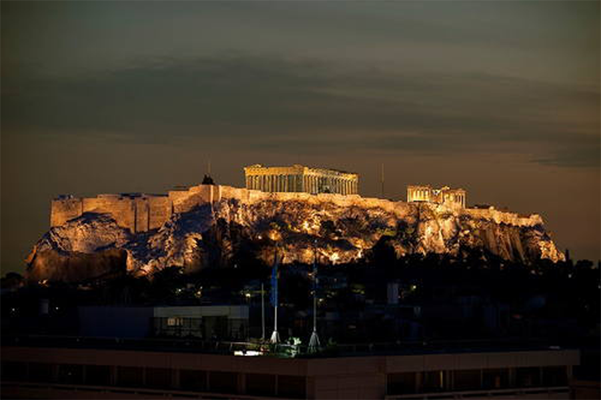
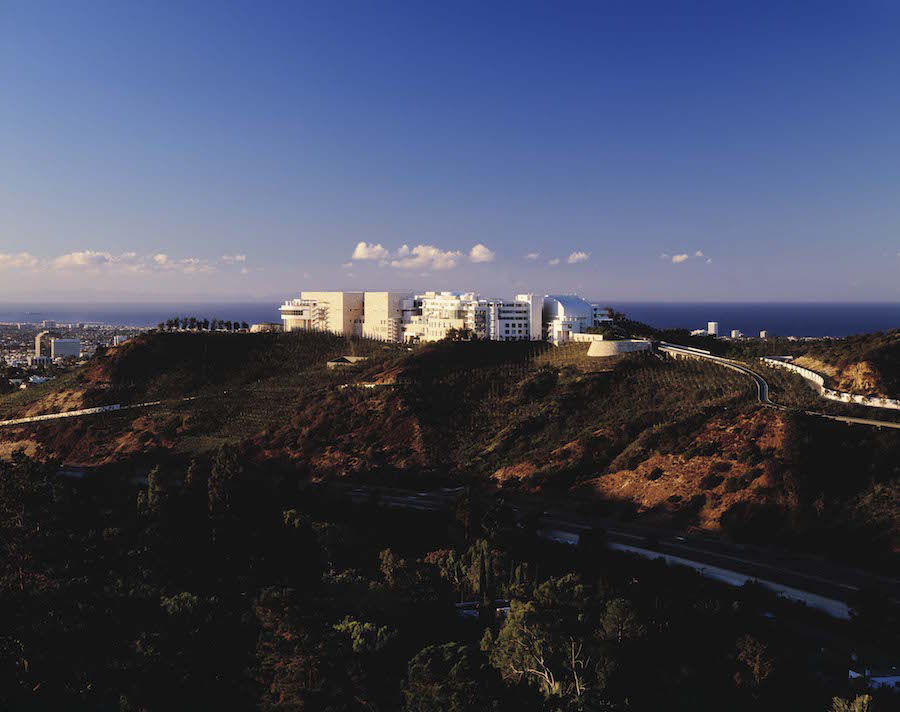
I can’t be in Los Angeles without stopping here, at the Getty Center. I alight from the tram that floats us on air up the steep and winding path, I start walking, and then it happens: my body is, I am, aware of being inside this network — of structures, angles, curves, widening vectors, trellises and pergolas with vistas, quiet empty spaces, stairs climbing the outside walls, tables and chairs awaiting on the mountain floor.
This place, which seems to rest against the sky, is tethered to the mountains and to the city below. It doesn't feel too airily high, it's weighted. It feels like it was always supposed to be here, waiting to have been uncovered.
Read ArticleClaire-Louise Bennett,
Her Living Images
Hey, nonny, nonny . . .
be you blithe and bonny,
Converting all your sounds of woe
Into. Hey, nonny, nonny.
— Wm. Shakespeare
None shally shally on that here hill . . .
None shilly shilly on that here first rung . . .
None ganny ganny on that here moon loose . . .
— C-L Bennett
The Universe Inside
The terrain of some writing is personal. Sometimes authors write about the small instead of the big. Their universe seems small because the writer is his or her own universe, which stops at the end of the body. So you have to go inside the body to get to the heart of the matter. Which means you have to go inside the mind, that is, the universe of the mind.
This is one of the hardest things in the world. This kind of writing may seem too simple-minded or self-obsessive to a reader who needs a bigger playing field, a reader who finds nothing compelling about a character who focuses on his or her daily life. But this is what many writers do.
You can’t automatically say that an author who writes about the small is narcissistic. It’s just that the writer starts somewhere, and then that place or experience entangles itself in set points within set boundaries. And then opens up, effusively and maybe in a paroxysm. Observation and recognition, not plot, move the story to its ending.
Writers who are good at this effortlessly take the reader through a character’s personal impressions and reactions, funny little likes and dislikes, to the resonant and not always conscious events they relate to, so that a story can start, say, in someone’s kitchen and end somewhere far away, say the cosmos.

Claire-Louise Bennett’s book Pond is such a collection of stories. She has a through-the-back-door style, one not seeking attention. Events often move like waves in her pieces, hitting the shore, receding, and thrashing up again carrying matter from ever lower sea depths. Sometimes her female narrators may seem claustrophobically self-centered, but this is only because their interest is in discovery and they tend to live within their own thoughts.
And what thoughts!
Read ArticleForbidden Fruit —
Tales From North Korea
Not under foreign skies
Nor under foreign wings protected
I shared all this with my own people
There, where misfortune had abandoned us.
—Anna Akhmatova, Requiem, 1961
Take it into town, happy, happy
Put it in the ground where the flowers grow
. . .
Shiny happy people laughing
—from REM's 1991 hit,
Shiny Happy People Laughing
Happy! Sad!
In North Korea, you must be happy. Or you must be sad. Not in an ordinary way, but extremely. It is written.
Nowhere else on earth are people so happy. The country has a joy index that measures it. Nowhere else are people so smiley. Their national television station shows them that they live in the happiest place on earth.

When they lose what they love the most, a dear leader, they are then the saddest people on earth. Nothing can contain their grief. It is that simple, that pure. Even the children cannot contain their sorrow.
The happy, or sad, crowded squares of North Korea are, of course, meant to showcase its strength and unity as a nation. The onus such outpourings put on ordinary, tired, and often hungry people, to line up and spend their energy, their day off, in a public square when they aren’t eager to do so, is a fraught matter. Every person knows his and her exact placement in all events, including the children, and one’s absence at any time is noted and punishable.
Read Article
Fall 2017/Winter 2018
What Is Money?
Why Pay Taxes?
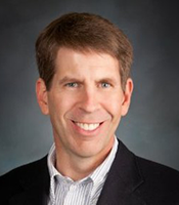
Money is created digitally, out of thin air. How can this be? When the federal government spends, it just deposits digits into an account. The government doesn’t go to Fort Knox to find the money, it simply changes the digits.
When we pay taxes, the opposite takes place. The government destroys the digits, takes money out of the economy. It doesn’t have to wait for the money to show up first, it simply changes the digits.
Once, for every dollar, there was a given amount of gold held in a vault in Fort Knox or wherever else the central banks held their gold. This limited the amount of money moving through the economy, because you had to have the gold in the vault before you could create the dollar. It put constraints on the central bank and the federal government.
Long after other governments around the world stopped the practice, the United States continued to give foreign central bankers gold for dollars, at the rate of about $35 an ounce in the 1960s. In 1971 Richard Nixon shut the gold window because we had too many foreign investors exchanging their dollars for our gold, and not enough gold.
Read ArticleHouse of Cards: The Big Investors Understand You
My grandfather made bricks.
My father made bricks.
I make bricks, too!
But where is my house?
—The old brick-maker in Federico Fellini’s film, Amarcord
A house is not a home. Except when it is. Even when it’s not, owning one provides something to depend on for the long run.
A house, a home, and something for the long run are what the young couple wanted when, child in tow, they offered the asking price on a house they liked on Jo Ann Drive in Spring Hill, Tennessee, the Nashville area where the husband’s new job was.
Little did they know that the snake was in the grass on the lawn, that American Homes 4 Rent (AH4R), based in Agoura Hills, California, offered the seller the same amount (not more), but for all cash and no inspection. The offer was too good to pass up, and the firm scored another touchdown — signed the contract 12 hours after the house went on the market, as reported by the Wall Street Journal on July 21, 2017.
Read ArticleNewthink Alchemy
For gold they say "Sun", for silver "Moon", for quicksilver "Mercury", for copper "Venus", for iron "Mars", for tin "Jupiter", and for lead "Saturn."
— Titus Burckhardt (References, p.77)
In the heat of the alchemical flask, liquid mercury vaporized (was released) to produce a purer form of the base ore. The alchemist called this distillation. He distilled saltpeter in alum to form nitric acid. In a corrosion-resistant vessel, he distilled sulfuric acid from alum. Fire made volatile materials stable and hard ones waxy, bendable, mixable.
This was serious business. Changing a substance into a solid, liquid, or gas; into a form more pliable or soluble; into jewel-like crystals, was more than transformation. It was transmutation, the alchemical term for the changes occurring as the "qualities" in the metal became purified through the chemical process (e.g., of distillation, coagulation, or dissolution). Transmutation allowed the impurities (dross) to escape and the metal to be released into its highest form, its essence.
And the highest essence was gold.
The true essence of lead is gold. Each base metal represents a break in the equilibrium which gold alone represents. (Burckhardt, p.47)
The cosmic correlate to gold was the sun, which mirrored the divine intellect. The earthly correlate to base metal was the human soul. The real goal was the transmutation of the soul into its perfect essence and union with the divine intellect.
This was not fusion; it was union — the divine intellect and the human soul shared some of the same properties and, therefore, mirrored each other. The alchemists often represented this symbolically in their crucibles as a mirroring of seeming opposites, as though there were a gravitational pull between them: downward and upward energies, lightness and darkness, sun and moon, gold and silver.

Read Article
Spring/Summer 2017
Medieval Mindfulness:
Bokes enlumyned ben þey
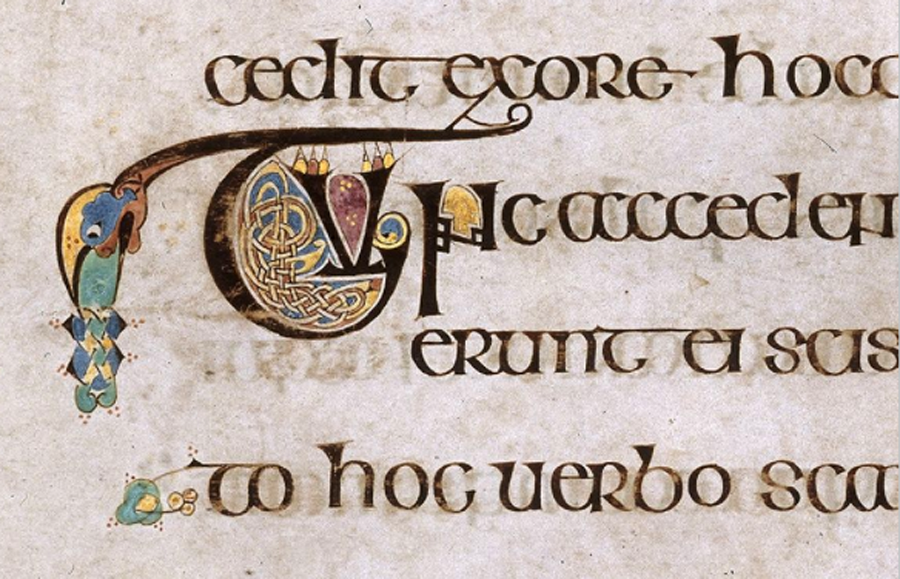
It’s a fact that when I see something medieval, I probably like it. Not that I don’t like other periods; I do, but medieval representations and accounts have a tactile earthiness and simplicity that aren't as available in these virtual days. There's more to it, though, it only looks simple.
It’s weird to hear people describe the European early middle ages as “the dark ages” — when nothing happened for hundreds of years (300 to 1100? I don’t know.). Europe was actually wildly afoot with merging and clashing cultures, mass migrations in every direction, uprooted peoples trying to make sense of the world, no longer knowing what to call themselves.
In the fourth century, rich young Romans were giving their parents apoplexy by forsaking their inheritances for a life of austerity and Christian meditation in the North African desert. In her book The Desert Fathers, Helen Waddell gives poignant descriptions of the life of these "athletes of God," as the desert dwellers came to be called. "Tell me ... If new roofs be risen in the ancient cities: Whose empire is it now that sways the world?" asked the desert father Antony of St. Jerome (Waddell, p.14, quoting Jerome).
Their life style added nothing of substance to the religious canon, Waddell writes, but their actions "showed a standard of values that turned the world upsidedown" (Waddell, p.22).
Read ArticleGreed & Fear, Inc.
The king was in his counting house
Counting all his money . . .
—From the nursery rhyme Sing a Song of Sixpence
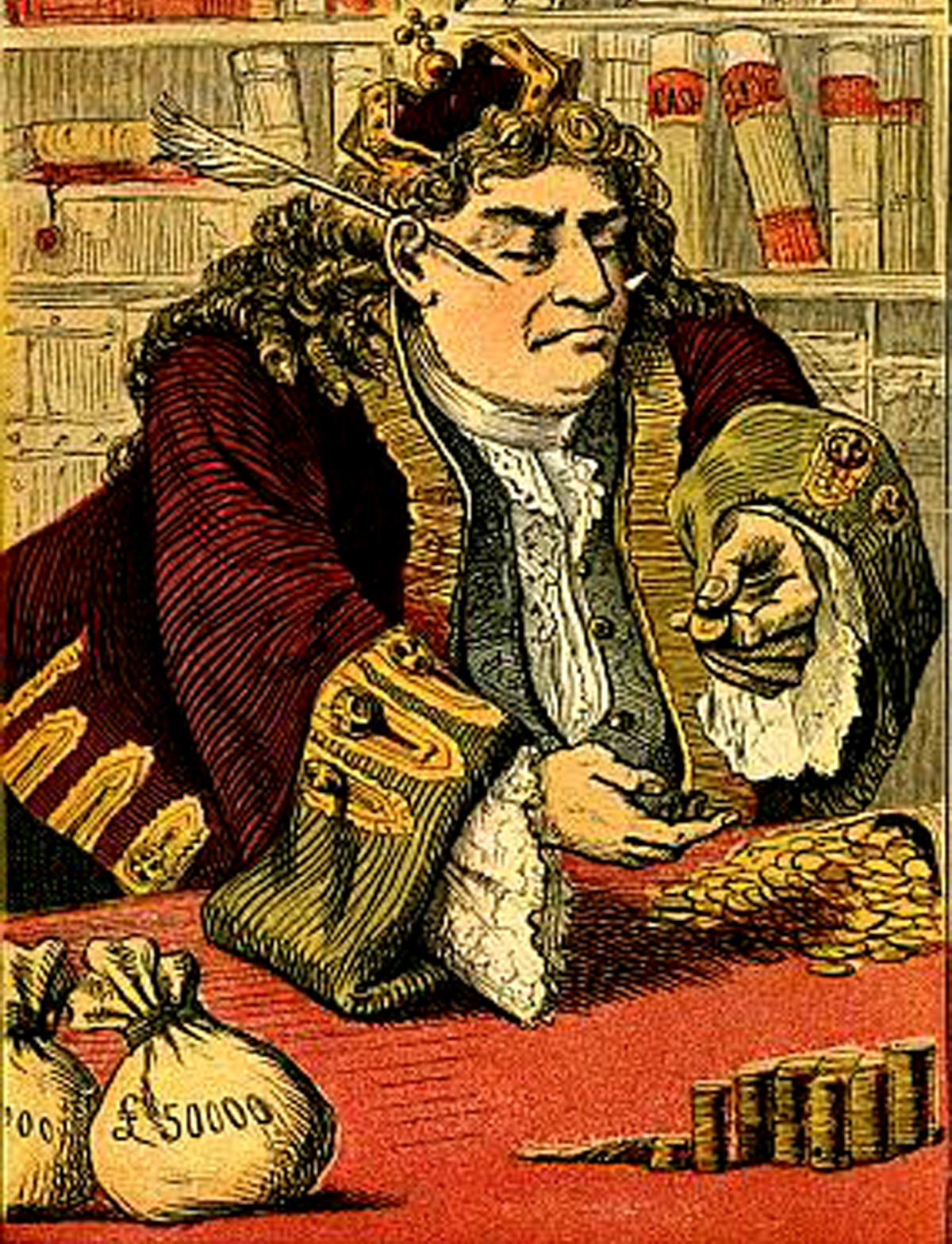
Anyone who tries to navigate his financial life without knowing something about the circuitous routes of modern finance is harming himself. Do you know the final stop of your mortgage payment? Which high frequency trading (HFT) platform trades your pension benefit? What that costs you? Who owns your local bank? That money is a game with made-up rules? That yours is “the dumb money”?
The February 17, 2017 Wall Street Journal had a front page story about a 68-year-old professional woman from Monterey, California who “lived like she was rich” until her fortunes collapsed in the recent recession. After declaring bankruptcy, she sold her condo for less than she paid for it and moved to an affordable community in Iowa, population 700, where she is enjoying a less expensive life.
Read Article王 忠杰, 画家
Wang Zhongjie, Artist
To explore, to create. The origin of life. To clash with life, clash with the canvas — that's the fundamental question.
—From the diary of Wang Zhongjie, 15 April 2008

All rights reserved.
忠杰, 长大当个画匠 !
"Zhongjie, when you grow up, become a painter!"
These are the last words Wang Zhongjie's grandmother said to her grandson, and they have burnished a place in his mind ever since. His grandmother was illiterate and Zhongjie was but a little boy at the time. He already loved to draw, yet could never have imagined that this would be his life's mission. Her remark, uttered perhaps lightly but more likely with conviction, became fused to his memory of his grandmother and sparked in him the idea and determination to set off on a long, difficult, solitary road. That of painting.
The term his grandmother used, 画匠 (huajiang), was “crafts painter,” a humbler designation than 画家 (huajia), the word normally used in artistic circles for “painter.” Perhaps the old woman was not acquainted with the loftier term. Young Zhongjie never had the chance to ask her about it, but it remained clear in his mind, a spiritual will bequeathed by the woman who had taken care of him, performing the day's tasks in her own no-nonsense way. We'll never know.
Read Article
Are Electric Vehicles Ready for Prime Time?

With the success of Tesla and the current trend to have every major car manufacturer offer an electric vehicle, it is becoming more important than ever to explain in simple language the essentials of the major fuel consumption difference between internal combustion engines and electrically driven vehicles.
There is some truth in the popular belief that electric cars are overall more environmentally friendly than those using internal combustion engines. The advantage would be even more enhanced through the production of cleaner electricity, from natural gas, solar, wind, or even nuclear power. Higher taxes at the gasoline pump would be a separate advantage.
It is crucial, however, to understand clearly the factors that can diminish and even eliminate the perceived advantage of an electric vehicle, namely how the electricity is currently generated and the vehicle's retail cost.
Here are some facts not clearly understood by many consumers. A zero emissions electric powered engine does not exist, yet. It is true that the driver of a Tesla (Tesla, Inc.), Nissan Leaf (Nissan Motor Co.), Chevrolet Volt (General Motors Corp.), or any of the other electric vehicles does not emit directly any carbon dioxide (CO2) while operating the vehicle. But the electricity does not get generated from thin air.
Read ArticleFall 2016/Winter 2017
If Birds Can Fly,
Why, Oh Why, Can't I?
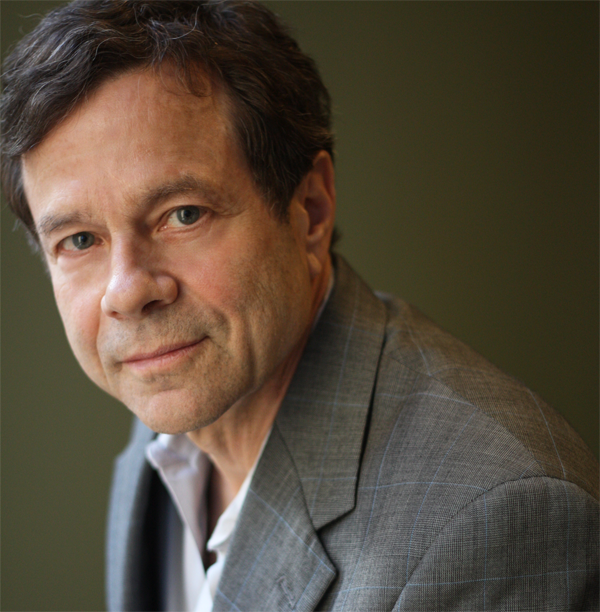
Human physical capacity is greatly restricted by natural laws, nowhere better illustrated than by our inability, despite vigorous and patient flapping of the arms, to fly. But the problem here is not simply the lack of wings. Scale up a pheasant to the size of a man and it would plummet to earth like a rock. Or consider Icarus. In the very plausible picture of him in my childhood mythology book, each attached wing equals his height and is about one quarter as wide—not unlike the graceful proportions of a swallow. Unfortunately, to fly with those wings the boy would have to beat his arms at one and a half horsepower, four times the maximum sustained output of an athletic human being. Icarus and Daedalus may have been willing to utterly exhaust themselves in their aerial escape from Crete, but most of us would like to go with better equipment.
Weight, shape, and available power all play a part in the science of flying. Let us begin with the most obvious requirement to fly: a lifting force must counterbalance the weight of the animal in question. That lift is provided by air. Air has weight and, at sea level, pushes equally in all directions with a pressure just under fifteen pounds per square inch of surface. To achieve lift, an animal must manage to reduce the air pressure on its top surface, thereby creating a net pressure pushing upward from below. Birds and airplanes do this with properly formed wings and forward motion. The curvature and trailing edge of a wing force the air to flow more rapidly over its top side than its bottom. This causes a net upward pressure in proportion to the air density and to the square of the forward speed, a basic law of physics deriving from the conservation of energy. Thus with every doubling of the speed comes a quadrupling of the lift pressure. No motion, no net lift pressure. Likewise, birds couldn’t fly on the moon, where the air density is essentially zero. (Under the moon’s reduced gravity, however, creatures could jump six times as high as on Earth, which might be a happy substitute.)
Read ArticleThe Lost World of
Old Europe
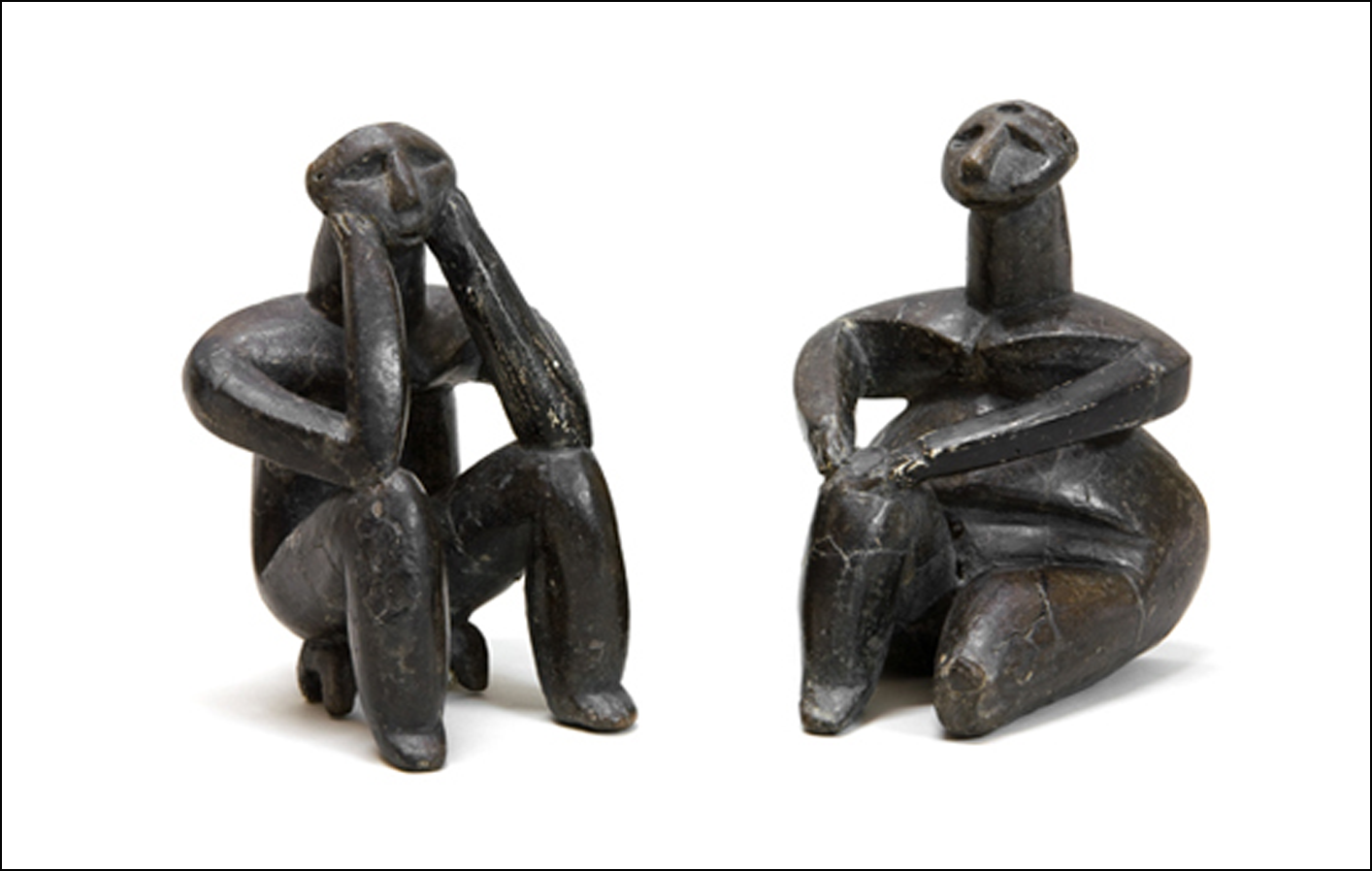
In 4500 B.C., before the invention of the wheel or writing, before the first cities were built in Mesopotamia and Egypt, Old Europe was among the most sophisticated and technologically advanced places in the world.
—David W. Anthony (ed.),
The Lost World of Old Europe, p.29
In honor of Rodin, let’s call the 7000-year-old couple above The Thinkers. Are they just thinking? Or mourning? They’re Europeans. Their facial expressions, their elongated necks, their heads tilted wistfully upwards, their attentive miens tell two tales. The first is the experience of the subjects, lost in thought and sorrow; the second is the consciousness of the prehistoric artist who sculpted these figures with such poignant focus. I’m far from the first to call these figures The Thinkers, but in fact it was my first thought when I saw them. This couple is genuinely modern. They are us.
The next image, also a thinker, has the same poignancy, reflecting consternation, hardship, beauty, and the artist's ownership of his art.
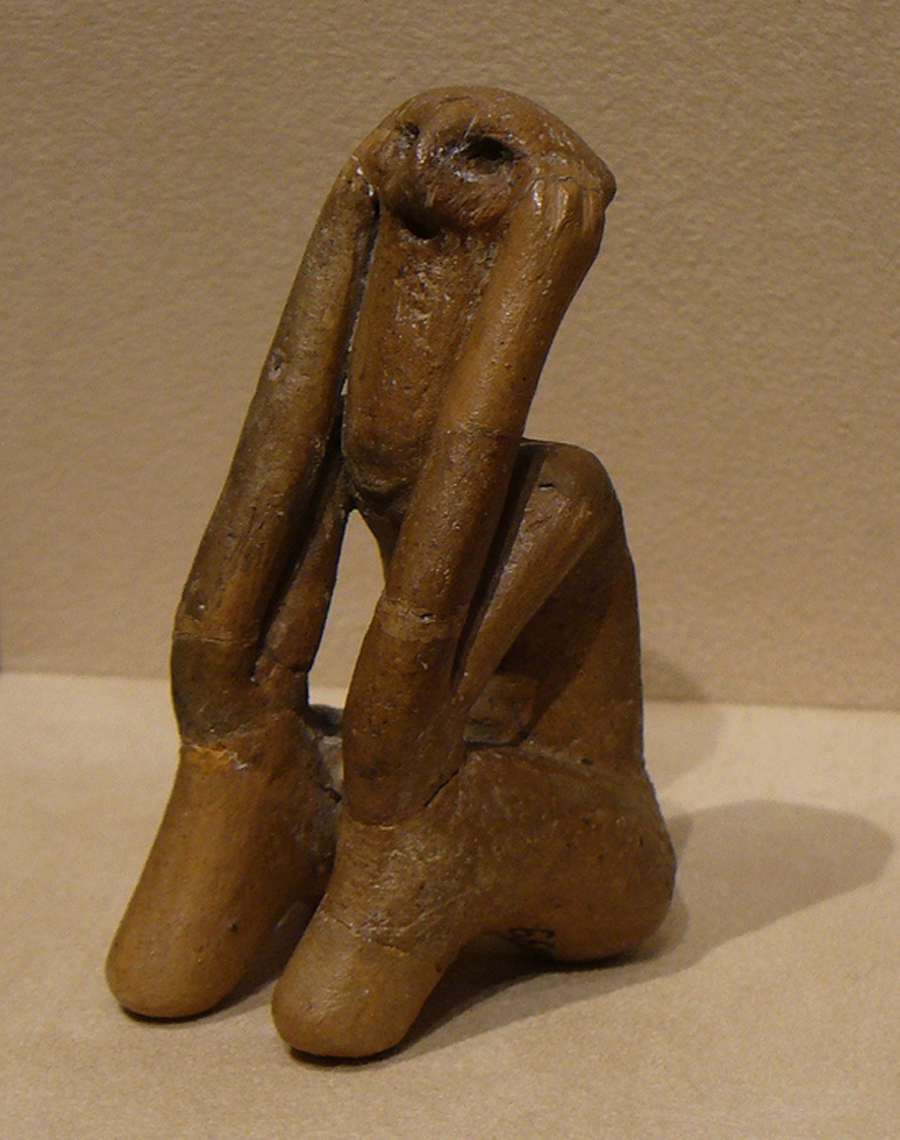
Read Article
U.S. Government's Insolvency —
Not a Bad Thing
Some people today say that the United States government is bankrupt. It’s usually said in a negative way that suggests that this is catastrophic and that at some point everyone is going to wake up and realize that the emperor has no clothes.
What does it mean to be insolvent, and why is that necessary for a country to function in a modern monetary system? I admit, how it works can be somewhat mind-blowing. It took me a while to understand the principles behind it.
First, we'll look at what it means to be bankrupt. Being bankrupt assumes that a court of law has declared you bankrupt, unable to meet your debts. This is a legal designation.
We’re going to get away from that term here, and focus instead on insolvency. Merriam-Webster’s definition of what it mean to be insolvent is: either (a) unable to pay debts in the usual course of business, or (b) having liabilities in excess of a reasonable market value of assets held. It doesn’t have to be both. It can be one or the other.
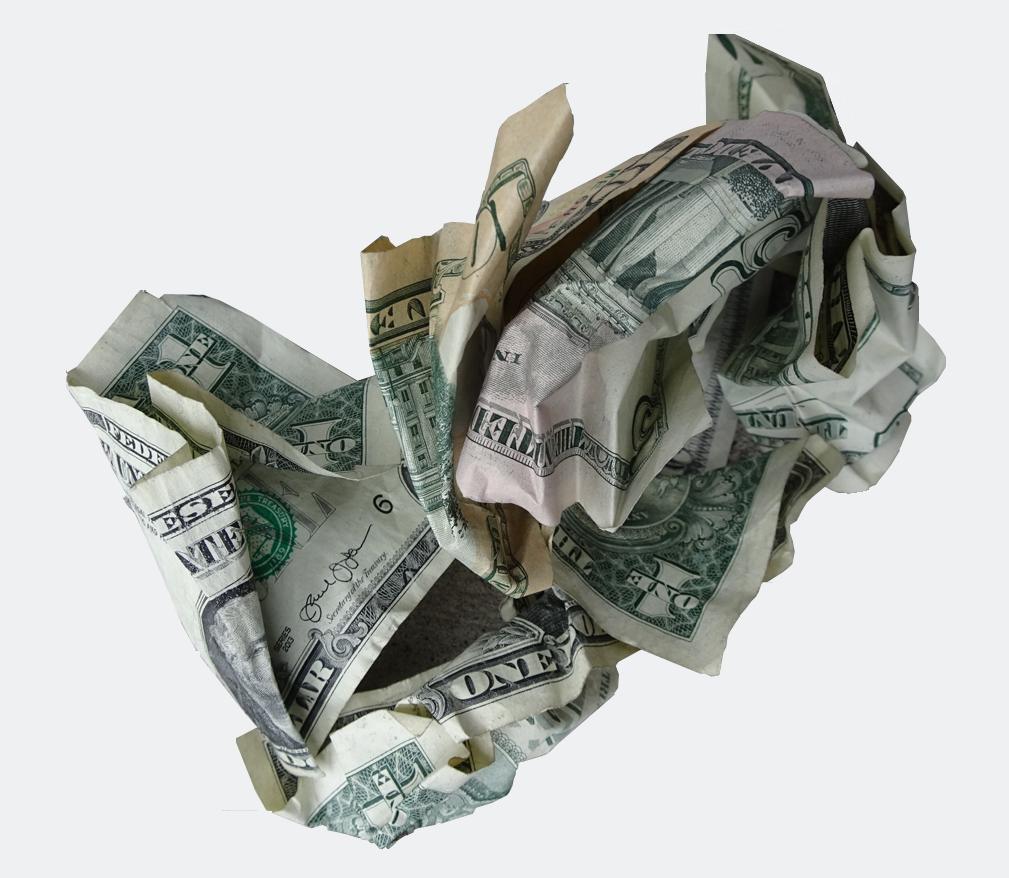
Read Article
The Singularity Nonevent; or, What Makes Us Human?

If we were all Ms. Brights, we could throw away those mega-vitamins. We’d get younger every time we came home. But we’d have a different set of problems, we’d never get to grow up.
Stumbling Into the Fray
I became aware of the boundary-pushing futurists accidentally. I was reading the Wall Street Journal and thinking about the connections between global finance, technology, and job loss, and how they have taken so many people unawares and left them stunned. I used to edit professional books, many of them in finance, and I've grown antennae for volatile economic headwinds.
I also love astronomy. Finance and astronomy have taken me to some strange places, but none as unusual as the conundrum that much-needed computer science talent is being diverted into an inquiry into reprogramming our humanity, mapping our neurology and biology as blueprints to change ourselves.
It started with Alan Lightman’s beautiful little book, The Accidental Universe. In his final chapter he talks about the effect of the unseen world on our understanding of reality — how quantum physics has revealed a world "almost unfathomable from our common understanding" of it (p.135). How ironic, he says, that the science which has brought us closer to nature by revealing the natural world to us is also separating us from it. Quantum mechanics, the science behind the technologies that drive our devices, is getting us used to experiencing the world a step away from our sensory reality. Will seeing a real snake in the woods someday be considered a less desirable or inferior experience to seeing its picture blown up on a screen? Will we prefer a disembodied self to what we have now, even if that means losing some of our human traits?
Read ArticleAncient Astronomers

and Local Government, Ireland
It has often been said that there is no human instrument more ancient ... than the sundial; it is a visible map of time. The earliest must have been erected in the Old Stone Age tens of thousands of years ago; but among the oldest now known are those built in Ireland during the neolithic period.
— Martin Brennan, The Stones of Time, p.40
Look at the black and white photograph above. What do you see? A grass-covered knoll, with trees and other growth, with some big rocks scattered at the bottom. And that is about all people in Ireland saw for centuries, until over a lengthy period of investigation starting in the late 1960s and continuing now, scientists and archaeologists realized that this mound (Newgrange) and others like it contain the cultural maps of an ancient people. How ancient? Radiocarbon dating places them in the neolithic age, starting in the fifth millenium BC.
For the curious, who we are and where we come from may never be answered, and what we discover along our way can undo what we thought we knew. In 2013, my husband and I visited the giant mounds, or cairns, of County Meath where, 5500 years ago, settled communities chiseled their calendar into stone. The mounds are the oldest buildings in Europe still standing, and their engraved symbols are the subject of an intense renewed study.
Ireland is young. People have only lived there for about 10,000 years. While ice sheets on the European continent retreated north before paleolithic times, they didn't recede from Ireland until 8000 BC, when the earliest mesolithic migrants began making their way to areas all over the island—in the north, along the coast, and into the interior.
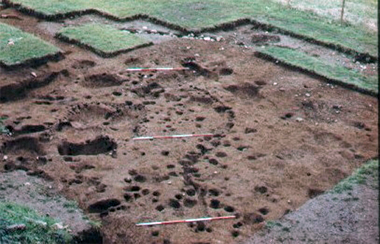
Some archaeologists believe the first migration was small, from Scotland, with settlers moving along the island's eastern shores, because of the similarities found in the mesolithic remains in both places. Peter Woodman, an Emeritus Professor of Archaeology at the Royal Irish Academy, has excavated sites in Coleraine, Northern Ireland, that date to 7900-7600 BC.
Read ArticleModernity Is More Expensive
Than You Think.
Our modern scientific and technological world is built on a belief in the autonomy of natural systems and the unbounded resourcefulness of science and technology as tools to understand the universe. Our faith in these systems, once thought liberating, has brought us pollution, a defoliated and ravaged wilderness, and nuclear threat, all symptoms of an environmental crisis that puts our existence and life on earth in jeopardy.
The golden age of science that ushered in the industrial revolution began with Copernicus, who in the early 1500s set in motion a series of inquiries that culminated with the publication in 1687 of Sir Isaac Newton’s Principia Mathematica. Scientific explanation spread widely, permeating the social fabric of western society and the globe. Science would free us from the burdens of scarcity and help us conquer nature. Our productivity and consumption would increase.
They certainly did, and we are now in an age of bondage to materialism, in which a focus on self-interest has estranged us from each other and brought us to an environmental precipice. We are working harder and craving more, some of us in an effort to fill an internal emptiness that no level of material consumption will satisfy. The priority we’ve assigned to increased production must be taken away if we are to deal successfully with the fallout bestowed on us so far.
Read ArticleSpring/Summer 2016
James Joyce, Italo Svevo & Leopold Bloom
“What in water did Bloom, waterlover, drawer of water, watercarrier returning to the range, admire?
Its universality: its democratic equality and constancy to its nature in seeking its own level...”
—James Joyce, Ulysses, Chapter 17, Ithaca
James Joyce's Leopold Bloom is a character at home with reality, and with the mysteries and potential of everyday life. Well-read, fairly cultured but not an intellectual, he excels at experiencing his thoughts and feelings as an activity — not unlike, say, the way a hiker might experience nature and his own sentient thoughts on a trek along the Appalachian Trail.
What else does Bloom admire about water?
... the independence of its units: the variability of states of sea: its hydrostatic quiescence in calm ... the multisecular stability of its primeval basin ... its vast circumterrestrial ahorizontal curve: its secrecy in springs ... its healing virtues: its buoyancy in the waters of the Dead Sea ... its properties for cleansing, quenching thirst and fire, nourishing vegetation: its infallibility as paradigm and paragon...
Does Bloom consciously delineate all of this in his mind as Joyce writes it? No, but he senses it experientially and would appreciate his creator's literary rendition of it. Bloom is more interesting, and nicer, than the young Stephen Dedalus, who “distrusted aquacities of thought and language.”
The middle-age Mr. Bloom is comfortable in his own skin, even while handling social slights throughout the day. He is a natural perceiver of the finer and the baser impulses of human nature, including his own nature. His range of thought and feeling as he wanders his city, noticing and processing what surrounds him, his responses internally and externally, are his Ulyssean journey towards home.
A Friendship
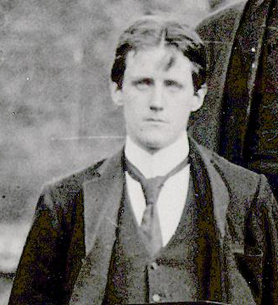
College, Dublin
Where did Bloom come from? Stephen Dedalus serves as a portrait of the artist as a young man, but Bloom represents something else entirely. After leaving Ireland with Nora Barnacle in 1904 at the age of 22, Joyce earned a salary teaching English at the Berlitz School first in Zurich and later in Trieste, on the northeast coast of the Italian peninsula, where he and Nora made their home. In 1907, he took on a student 20 years his senior, Italo Svevo, with whom he enjoyed discussions about literature and writing. The two established a lifelong friendship. The highly cultured, well-traveled Svevo was Joyce's inspiration for the person of Leopold Bloom, including Bloom's Jewishness. Joyce admired the strong family ties and moral conscience he saw in his Jewish friends, qualities that describe Joyce himself.
Read ArticleLessons From the Yucatan
Many years ago I met a Mayan couple in the Yucatan that seemed incredibly happy. They were in their sixties and they lived in an oval one-room house. The house walls were made of vertical sticks and covered with clay that had been painted white on both the interior and exterior. The roof had a steep pitch and was laid with thatch. There were no windows, just a front and a back door.
The main piece of furniture was a large handmade armoire where the couple kept their clothes and other valuables. There were a few chairs, a table, and two hammocks hanging on the wall that they would unfurl and stretch across the room for sleeping.
Read ArticleThe Potion?
It's Not What You Think.
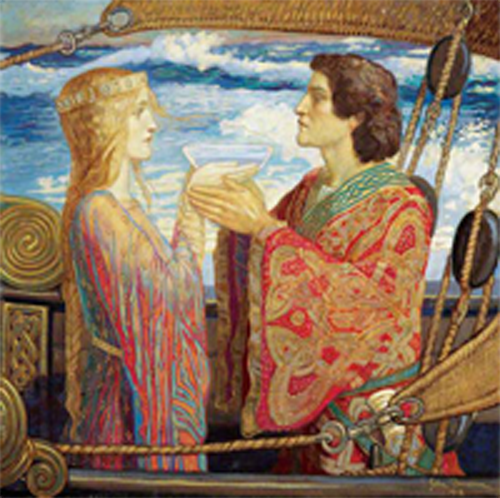
City Art Centre, Edinburgh, Scotland
Let all men in their thoughts gaze only at Ireland, let their eyes take pleasure there and see how the new Sun following on its Dawn, Isolde after Isolde, shines across from Dublin into every heart. ... Whoever looks Isolde in the eyes feels his heart and soul refined like gold in the white-hot flame. ... she adorns and sets a crown upon womankind.
—Gottfried, p.151
The medieval tale of Tristan and Iseult exposes elemental, urgent passions and needs. Sometimes the struggle with them is ferocious. Sometimes the struggle is simply to stay alive.
Large fragments survive of three versions of the story written between about 1160 and 1213 − those of Beroul and Thomas in the Anglo-Norman tongue of their native Britain, and Gottfried of Strassburg’s in German. They wrote with love for their characters and empathy for their suffering.
The authors did something else. They gave us characters with sophisticated thought processes and careful self-awareness. Thomas and Gottfried created a new kind of story, to be read privately, not simply recited as reliable entertainment at court. They worked within the tale’s constraints of Celtic mythical elements and European courtly norms, but they (like other great medieval writers) set the tone and standards for their compositions. What each created was a literary work whose probing into the shadow world of human emotions, motives, and behavior presages the great novels of later ages.
Even Beroul, whose version is the oldest and most enchanted, interjects his feelings at pivotal junctures in the narrative so that we know where he stands. When, for example, the evil dwarf Frocin insists that King Mark banish Tristan or lose the support of his own court, Beroul inserts into the text, “Cursed be all such magicians! … May God curse him!” (Beroul, p.61)
Read ArticleColleges and Universities:
New Peddlers of Subprime Mortgages
It is probably not much of an exaggeration to say that there is a unanimity that the Great Recession of 2007 is the most significant financial disruption witnessed in the United States since the Great Depression. But what is more significant is that most parties believe that the direct trigger for this financial calamity was the phenomenon of subprime mortgages. These were the highly profitable mortgages that financial institutions could not produce, package, and sell fast enough.
The profitability associated with these mortgages, sold to households and individuals who could not afford them, is best illustrated by what Charles Prince, CEO of Citibank at the time, told a Japanese interviewer: “As long the music is playing, you've got to get up and dance. We're still dancing.” His statement shows a certain moral depravity. It simply says that the great United States financial system could not stop knowingly exploiting a large segment of U.S. households as long as the sham operations produced great profits and even greater bonuses.
Read Article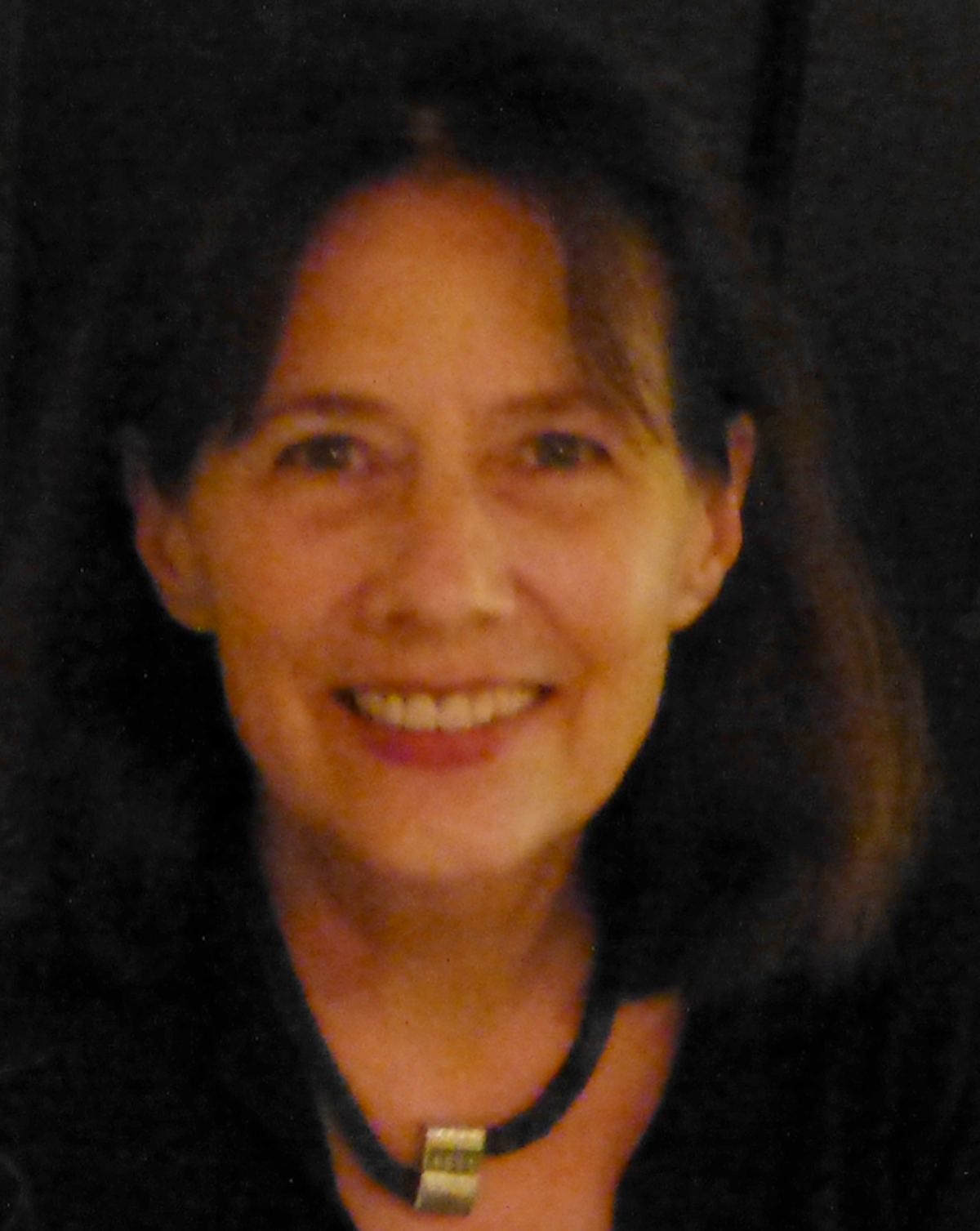
Hello and Welcome!
[Note: Please refresh your browser. I do tweak my articles and fix errors as I find them. Thank you.]
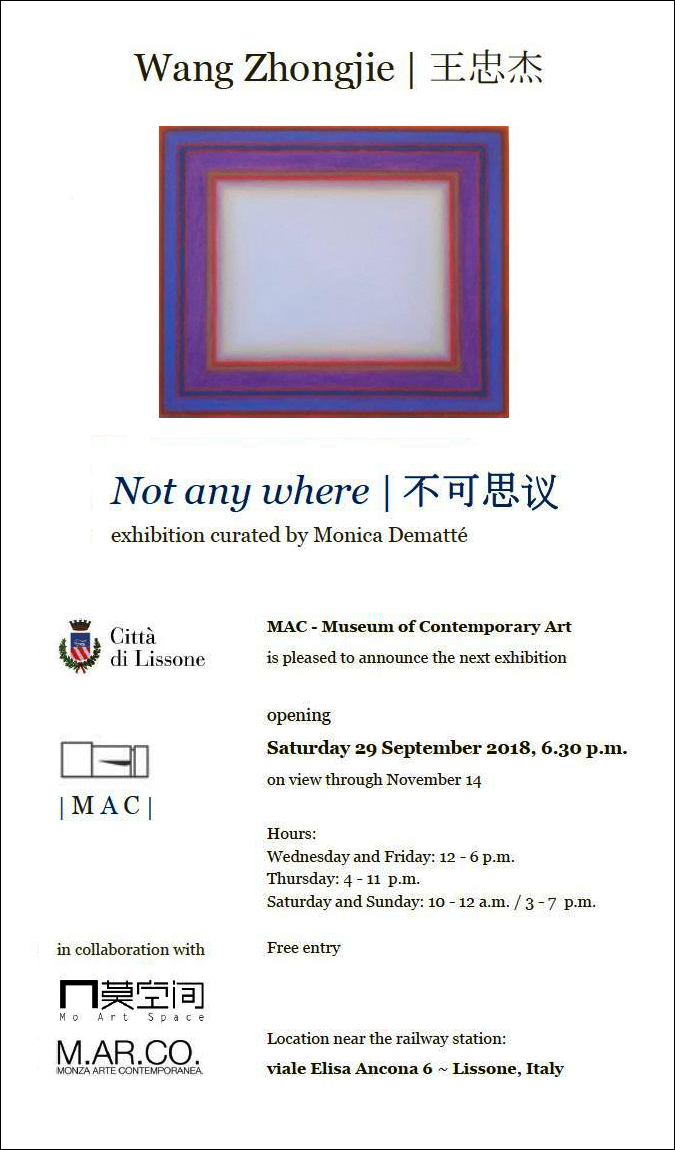
In the summer of 2017, the Italian art curator Monica Dematté wrote a piece in this website about the Chinese artist Wang Zhongjie, with whom she has worked extensively in Henan Province, China.
Monica curated a show of Zhongjie's work in the Lissone Museum of Contemporary Art in Lissone, Italy (near Milano), in September 2018. Zhongjie was present for the show's opening, which provided him the opportunity to share his art with Western viewers and the viewers the opportunity to see some of the art coming from China. It is mostly Zhongjie's earlier art, and Monica's earlier experiences with him, that she shows and describes in her article, but she includes much of Zhongjie's contemporary work to show the progression to his framelike color compositions. These works have rich monochrome surfaces, the result of the superposition of many layers. An inner light emanates from them that renders them luminous. The Internet does not do justice to this luminescence.
If you've been to this website previously you've already read why I call it Iseult & Bloom, but if you're new to the site, here's a condensed explanation: the medieval story of Tristan & Iseult and James Joyce's Ulysses are two works whose influence on me hasn't changed over the decades since I first read them in graduate school at San Francisco State University.
My opinions on things have grown and changed over the years, but my appreciation of these books and and their authors has stayed with me and grown with each reading. To me, they're recommended reading.
The articles on Iseult (The Potion) and Bloom (Joyce, Svevo & Bloom) speak for themselves.
The Getty Center in Los Angeles
Have you been there? To the Getty Center in the Santa Monica Mountains? I go to every time I'm in Los Angeles.
I always take in the exhibits, but my favorite thing about the place is the architecture. I never studied it formally, but on my most recent trip to the Getty I took an official tour, which gave me insights into the thinking of the Getty's architect, Richard Meier.
From there, I started reading. So much went into building this place, this Acropolis for the public. The money, the years, the sweat, not to mention the story that made it possible, the bequest of John Paul Getty.
There is an inherent contradiction in the fact that the wealthy, the very wealthy, own the art world, because art and culture are about people, not wealth. Wealth is acquisitive. Art is not.
Meier's public architecture is about people. So was Mr. Getty's gift.
Claire-Louise Bennett's tales: Pond
Pond is a collection of stories by Claire-Louise Bennett that was first published in Ireland in 2015. As they say about Karl Knausgaard's memoir-style novels, even the boring parts are good. I don't want to say a lot here, but I think her descriptions of the internal life are luminous.
All Quiet on the Korean Front?
The loudspeakers along the 160-mile border between North and South Korea are momentarily silent. The soldiers on either side might be able to hear their own thoughts instead of the warring propaganda that usually spews forth so far and so loud it destroys their eardrums.
Kim Jung-un continues the follow-the-leader policies set forth by his grandfather and father, but the benefits for himself and his people are precariously running on empty.
Up until now, our "inside" information about life in North Korea came from people who successfully fled. Now we have Bandi, the insider whose fiction has made it out, even though he or she has not.
The Newthink Alchemists
Newthink alchemy — "newthink" because the people trying to push technology towards post-humanism have opened up a new category of conversation, and "alchemy" because the goals remind me of medieval alchemical goals. Some of the parallels are striking.
It was after reading Yuval Noah Harari’s books, Sapiens and Homo Deus, that I knew I wanted to read more about transhumanism. I forced myself to listen to more of the futurists' endless videos on YouTube.
Newthink ideas are often delicious and they can make your brain cells spin. It's just that I have a problem with their inherent gnosticism. Gnosticism wants to deny the body, our one and only vessel. As interesting as it is to read about, and it is very interesting to read about, the newthinkers seek an improbable conclusion, like their medieval prececessors.
Medieval alchemical and gnostic ideas never took hold in the broader imagination, probably because they were secretive, esoteric, and not widely advanced. The ideas didn't offer what the broader world seemed to need. Alchemical symbolism was sun-centered, veering toward a Copernican view of the universe, which may explain the secretiveness of the ancient alchemical philosophers. Ordinary ancients and medievals alike would consider such thinking heretical.
It's a little different with today's newthinkers, who are messianic rather than secretive. Facts about artificial intelligence are important to know. But many newthink ideas are unproven, and science requires proof. Too many fascinating ideas spilling into one another have the potential of cheapening them.
This has little to do with technology. The ideas are born in Silicon Valley, I guess, but they're not really about technology.
House of Cards: The
Big Investors Understand You
We're not Singapore or Switzerland. We're not even Germany or the United Kingdom. We have our own traditions that go back to 40 acres and a plow, and a home of one's own.
The single family home rental businesses that private equity and hedge funds are starting in the United States do not fit the classic REIT formula and do not arise from the expectations of the people facing these investors for the first time — people looking not for apartments, but for houses.
The investors' exit strategies are also in place in the event the trend doesn't gain the steam they want. Then what?
Medieval Mindfulness
Wang Zhongjie
画家 (huajia, painter)
Her art space is an extraordinary place that provides artists with residency, ample exhibition space for their works, and freedom from financial exploitation.
Monica formerly was a professor of art at the University of Bologna. I am so happy to present her article on the works of the artist Wang Zhongjie, a native of Zhengzhou whom she "discovered" years ago and with whom she has worked closely ever since.
This short video of the Mo Art Space, 超过物展览视频(邢志昊), is beautifully done. And here is a newly created three-dimensional tour of the space, courtesy of Monica.
Xing Peijun, director of the Mo Art Space in Zhengzhou, sent me some images of Zhongjie's works from the last two years, which I added at the end of the article.
Greed & Fear, Inc.
I just finished reading about some of the working homeless in New York City. A woman who works two jobs in the service industry, twelve hours a day total, five days a week, does not make enough to pay her rent and has been living in a homeless shelter since October 2017.
She lives down the street from billionaires, to whom she is invisible. Hers is one of many such stories. There's a lot more bravery at the bottom than at the top, that I can tell. These days, more than Wall Street seems to be running on greed and fear.
If Birds Can Fly ...
Nothing matches the intricacy and strength of a feather. Birds have propellers on the outer halves of their wings that provide lift in the forward direction. I didn't know much about the mechanics of aviation before Mr. Lightman sent me this, but when my husband and I drive northward through New York's Hudson Valley, we're always on the lookout for the hawks. Some have six-foot wingspans, soaring majestically above.
Our attempts at solo flight are only fulfilled, as Lightman says, in our dreams. From Aristotle to the Gossamer Condor, it's been an awkward effort.
Ancient Astronomers
The "Singularity"
Around the world, people are listening — some happily, some fearfully — to the eternal-life and computational futurists who envision altered humans, semi-cyborgs, machines that are essentially human, and eternal life within a cosmos whose physical laws no longer preclude our demise.
My responses are complex. The futurists took me places that forced me to make some decisions about what I really think and feel.
Old Europe: 5000-2500 BC
"Old Europe" refers to the present-day Balkans—coastal areas along the Black Sea, the Danube River, and other waterways in what is now Bulgaria, Romania, Moldova, and the Ukrainian steppe.
In the past, archaeology seems to have been focused on finding and dating: carefully combing through sites to preserve found artifacts, skeletal remains, and other telltale signs of ancient civilizations, using radiocarbon dating and other techniques to discover their age.
Now archaeology is aided by genetic testing of skeletal remains, and also by a studious approach to discovering to the extent possible the meaning of what is found. There is now great interest in the symbols and codes of neolithic cultures.
I have already discussed the study of the codes used by the ancient astronomers in Ireland. In Tărtăria, Romania, inscribed tablets dated to about 5000 BC may have been an ancient form of accounting, which would make them one of the oldest forms of human coding ever known.
I do think that the two ancient cultures, Irish and Balkan, share a connection. Some of the later (circa 3000-2500 BC) migrants to the Irish isle who sailed through the Strait of Gibralter and up the Atlantic Ocean were originally from areas I discuss in my Old Europe article, metallurgists from the Ukrainian steppe.
I don't know how archaeologists would respond to my making this connection, but it's plausible.
It also makes me wonder what people in other parts of the world were doing in this time period, which seems to have been epochal in our human history even though it is elusive.
The Economy
Ghassan Karam, in his article on electric vehicles, counters the effects of electricity production methods and vehicle cost against the environmental friendliness of these cars, and brings to light important but somewhat hidden considerations that most of us would not come up with on or own.
As usual, things are always more complicated than we want them to be.
When is the last time a federal agent knocked on your door to collect the amount each family member owes on the national debt? You know—the debt your grandparents left for you to pay off, the same debt you're leaving for your grandchildren.
Never? Oh.
Well, there's a reason for that. You wouldn't know the reason, listening to some of our legislators. They should read J. David Stein's article on why the national debt is not necessarily a bad thing, hanging around as it has for about 100 years.
We're an interesting country. One reason the debt exists is to ensure that the savings and property of households and businesses don't get decimated.
If you haven't started listening to J. David Stein's weekly podcast Money for the Rest of Us, do plug yourself in. David has the gift of attention to the ordinary.
Ghassan Karam's article on how expensive modernity really is comes from his concern as an economist about the obsessive pursuit of profit and its effect on our environment and our quality of life. I rarely see this issue discussed in financial and business publications, or in political forums, yet the effects are palpable, even if they're not understood.
Feedback
Please give me some feedback! I began the site saying that I didn't want to have a Comments
section because I've gone through too many Comments sections on all kinds of websites just shaking my head at some of the nonsense, prejudice, and ignorance that shows up (not all, of course). But I want to hear from you and have set up the Reader's Page for feedback.
You can comment on the Contact page. Hit the link at the bottom of the articles. If you don't want to fill in the blanks, you can email me directly from the Contact page. I really do want to hear from you and am very thankful for the few notes that have come in from readers (see the Reader's Page).
Old ... New ... Great
Alan Stivell
He too mixes the modern with the traditional. Tri Martolod (Three Sailors) is wonderful and a true crowd pleaser. His album Renaissance of the Celtic Harp (photo below of 1982 record jacket) is the first music of his that I heard, beautiful and comforting.
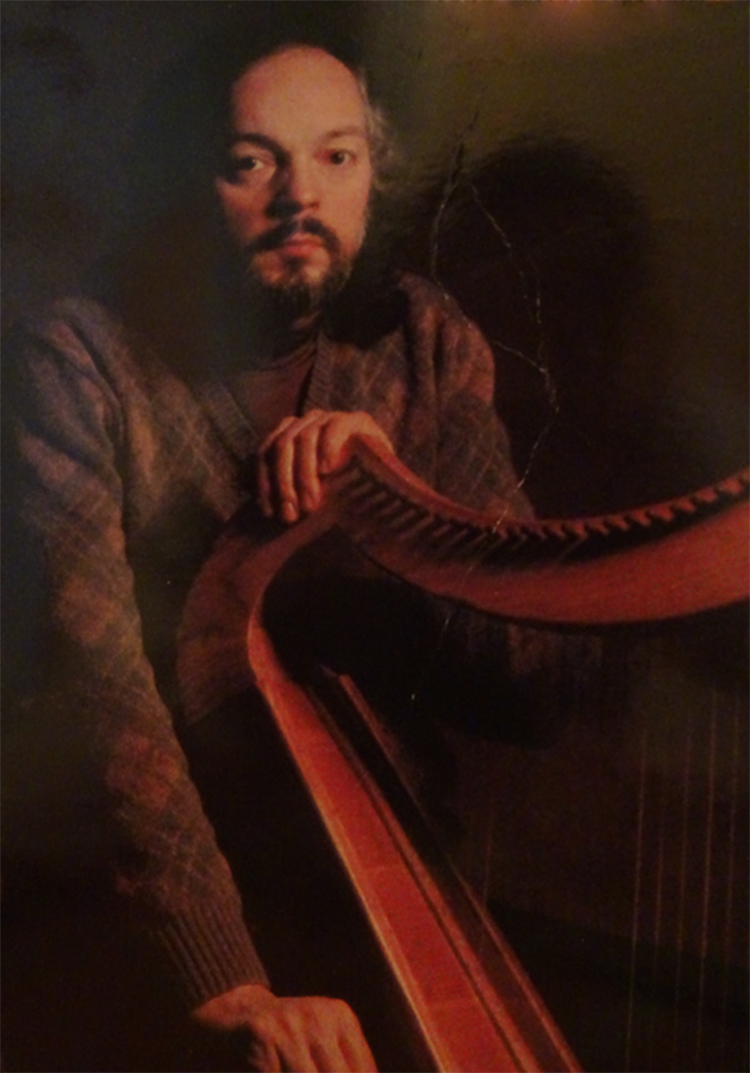
Photograph by Frances Stevens.
© Rounder Records 1982.
Gerard Edery
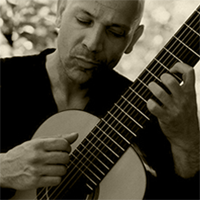
© Gerard Edery
I first heard Gerard Edery live and then sought out his music. My favorite CD of his is Linda Amiga, a collection of medieval Spanish love songs, half of which are songs of the Sephardim. The YouTube clip here of Linda Amiga shows the album cover but plays only the first song. A few other songs on this album are:
Tres Morillas, anonymous & popular medieval Spanish—
No La Puso Su Madre, traditional Sephardic—
Avrij Mi Galanika, traditional Sephardic—
Edery has a web page he calls The Ladino Song Project, which provides the medieval Spanish/Ladino text and English translations of these and other songs.
Nassim Nicholas Taleb Interview
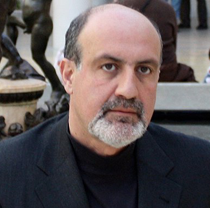
Image courtesy of Sarah Josephine Taleb, via the Taleb image gallery .
I haven't found a lot of good book reviews of his book Skin in the Game, but there is this 20-minute YouTube video of Randy Mayeux at First Friday Book Synopsis, who gives a decent description of this serious, funny, deep book. I love the Silver Rule: Do not do unto others what you would not have others do unto you.

